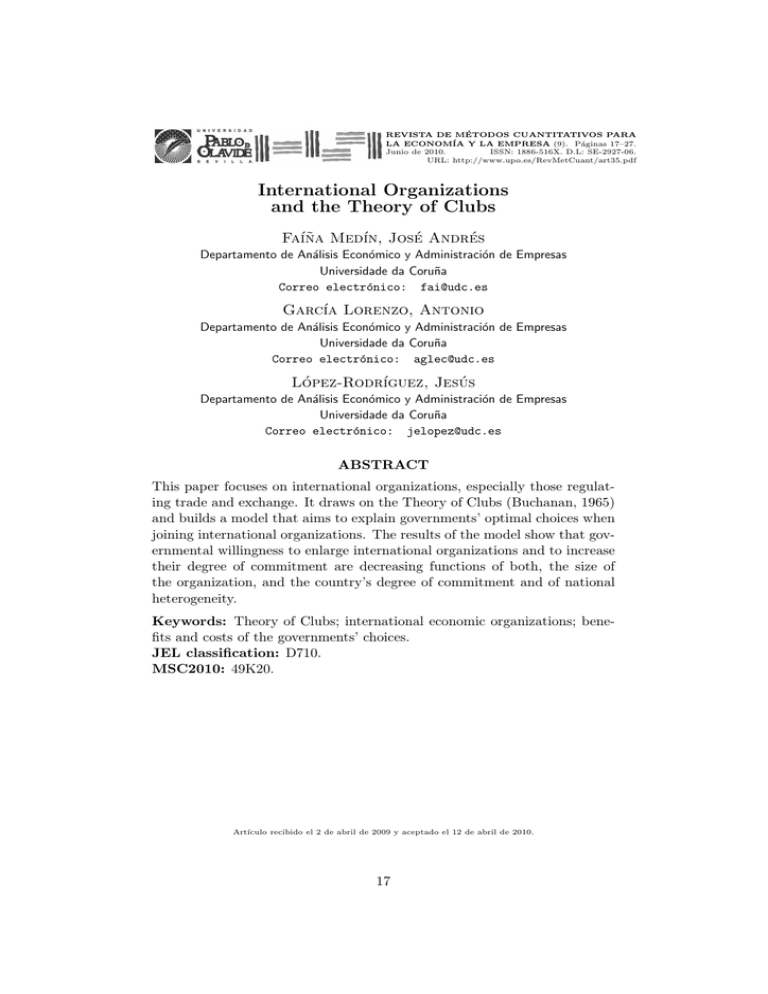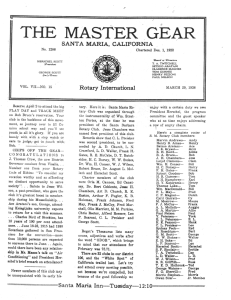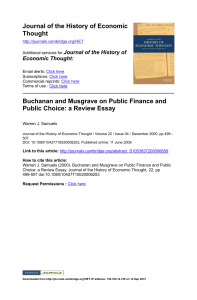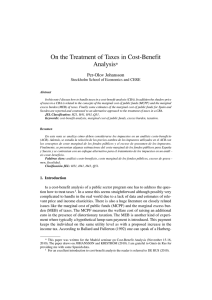International Organizations and the Theory of Clubs
Anuncio

REVISTA DE MÉTODOS CUANTITATIVOS PARA LA ECONOMÍA Y LA EMPRESA (9). Páginas 17–27. Junio de 2010. ISSN: 1886-516X. D.L: SE-2927-06. URL: http://www.upo.es/RevMetCuant/art35.pdf International Organizations and the Theory of Clubs Faı́ña Medı́n, José Andrés Departamento de Análisis Económico y Administración de Empresas Universidade da Coruña Correo electrónico: fai@udc.es Garcı́a Lorenzo, Antonio Departamento de Análisis Económico y Administración de Empresas Universidade da Coruña Correo electrónico: aglec@udc.es López-Rodrı́guez, Jesús Departamento de Análisis Económico y Administración de Empresas Universidade da Coruña Correo electrónico: jelopez@udc.es ABSTRACT This paper focuses on international organizations, especially those regulating trade and exchange. It draws on the Theory of Clubs (Buchanan, 1965) and builds a model that aims to explain governments’ optimal choices when joining international organizations. The results of the model show that governmental willingness to enlarge international organizations and to increase their degree of commitment are decreasing functions of both, the size of the organization, and the country’s degree of commitment and of national heterogeneity. Keywords: Theory of Clubs; international economic organizations; benefits and costs of the governments’ choices. JEL classification: D710. MSC2010: 49K20. Artı́culo recibido el 2 de abril de 2009 y aceptado el 12 de abril de 2010. 17 Una interpretación de las organizaciones internacionales utilizando la Teorı́a de los Clubes RESUMEN El trabajo se centra en las organizaciones internacionales, concretamente en aquellas que regulan el comercio y el intercambio. Basándose en la Teorı́a de los Clubes (Buchanan, 1965), se construye un modelo para explicar las elecciones óptimas de los gobiernos a la hora de formar parte de una organización internacional. Los resultados del modelo muestran que los deseos de los gobiernos de aumentar tanto el tamaño de una organización internacional como su grado de compromiso son funciones decrecientes del tamaño de la organización, del grado de compromiso de los paı́ses y de la heterogeneidad nacional. Palabras clave: Teorı́a de los Clubes; organizaciones económicas internacionales; beneficio y costes de las elecciones de los gobiernos. Clasificación JEL: D710. MSC2010: 49K20. 18 1. INTRODUCTION Governments can make themselves better off by setting up or joining international organizations. They may benefit from their international club memberships through three main channels: 1) higher bargaining power at the international level; 2) reductions in the negative externalities arising out of unconstrained threats and pressures among governments; and 3) the opportunity of transferring domestic political costs to supranational jurisdictions (governmental collusion). Nevertheless, the decision of entering an international organization is not cost free. Rather, the cost of doing so is derived, essentially, from the expected losses that may be incurred by adhering to the binding decisions of the organization that are not beneficial to a particular member government (imposition costs). Moreover, the number and quantity of services an international economic organization is expected to provide its members, strongly depends on the members’ degree of commitment. This captures the strength of the ties linking governments within an international club1. The variable degree of commitment may play a role that is analogous to that played by the quantity of goods and services in the theory of clubs (Buchanan, 1965). The theory of clubs is, therefore, a suitable analytical framework2 for analyzing the rationale behind governmental support for international organizations3. The present paper draws upon the theory of clubs to build a model which studies governments’ optimal choices with respect to joining international organizations. These organizations vary in size and degree of commitment. The model considers two main sets of variables that characterise economic international organizations. On the one hand, two inter related variables: the size of the organization and the number of member governments; and on the other, the degree of intergovernmental commitment generated by the organization. The degrees of commitment and the number of members provide our model with a club structure. When deciding to join international organizations governments face a trade off between participation and independency. The role that the degree of commitment plays in our model is analogous to that played 1 See Congleton (2004) for an analysis of membership decisions when the quality of the clubs’ services is uncertain. 2 For a comprehensive survey on the economic theory of clubs see Sandler (1992), Sandler and Tschirhart (1980) and Anderson et al. (2004). 3 The theory of clubs has been applied in different fields. In the field of economics of religion it has been used to study the optimal size of a religious congregation (see Zaleski and Zech, 1995) and other related issues (see Galbraith et al., 2007). In the field of economic growth, it has been used to study the convergence of new approaches to endogenous economic growth and to regional growth, and to prescribe policies to create technology parks as instruments for regional economic growth (see Alvarez-Gonzalez and Diaz-Perez, 1996, and Prakash and Potoski, 2007). In the field of insurance, it has been used to develop criteria for organizational structures of social insurance to be efficient (see Breuer, 1999). 19 by the size of the facility4 in Buchanan’s theory of clubs (1965), although in our model the framework is somewhat more complex. Unlike Buchanan’s (1965) model, the foreseen benefits that member governments expect upon entering an international organization featuring a given degree of commitment can be considered to be a positive and increasing function of the size of the organization. This implies that there are no congestion points on the benefit side of the model. Quite the reverse in fact, the expected costs of becoming a member of an international organization is an increasing function of the size of the organization and of the required degree of commitment. This is due to imposition costs which increase very rapidly as the size and degree of commitment increases. Within this framework, costs evaluation, which increases with size, plays a role which is analogous to that played by congestion in Buchanan’s (1965) theory of clubs. Further, unlike Buchanan’s (1965) model, the limit to the enlargement of governmental clubs arises from the cost side rather than from the benefit side of the model. For low degrees of commitment, binding decisions can be made only on the grounds of intergovernmental unanimity, and this will make the efficacy of the organization rather low, thus reducing the quantity of services the organization is expected to provide. A way to raise the amount of expected services provided by the organization is by increasing commitment ties. Departing from the unanimity rule in the decision making process, and moving towards less inclusive decisions rules –ranging from highly qualified majority rules to less strict rules such as weighted majorities– is the common way to increase the quantity of jurisdictional services provided by the organization. This process involves augmenting the services provided by the club, but also implies increasing expected costs, which are highly sensitive to national heterogeneity. Consequently, the expected costs for member governments limit the expansion of clubs. Our analysis features a highly innovative version of Buchanan’s (1965) model, which deals with governments’ optimization processes: 1) given the size of the club (N), there is an optimal degree of commitment (a); and 2) given the degree of commitment (a), there is an optimal size of the club (N). The optimal combination of size (N) and degree of commitment (a) is usually unattainable since size can only be enlarged discretely, i.e. by incorporating a new member government of size (Nj) to the club. The remaining part of the paper is structured as follows: Section 2 briefly describes the different rules governing international agreements. Section 3 formally presents the model, analyses the possible benefits and costs that may arise out of governmental choices, and assesses the willingness of countries to engage in international agreements. Finally, Section 4 presents the main conclusions of the analysis. 4 By “facility”, Buchanan’s (1965) model refers to goods or utilities shared by the club, for instance a swimming pool. 20 2. DIFFERENT RULES FOR INTERNATIONAL ECONOMIC AGREEMENTS Rules form the basis of a framework for cooperative social interaction among governments. They set up bounds for the range of potential intergovernmental outcomes in order to keep their probable sequences within some degree of Pareto optimality. Every rule, mr , constrains the set of all possible intergovernmental states, X . The subset of intergovernmental states associated with a given rule can be defined as: X mr = [X possible under mr] Government utility functions can be mapped into the set of rules. The expected utility of foreseeable governmental positions can be envisaged as a subjective evaluation of the rules themselves. This evaluation is a mean of the expected values that have been discounted over time. With time, deviations from the mean will be expected to increase while the weight of the periods themselves will decline and converge to a finite quantity. Expected deviations are an important factor when it comes to making choices under conditions of risk. This paper uses Von Neumann-Morgenstern cardinal utility functions for governments which assign a cardinal utility number to each of the possible results and choose the rule that maximizes their expected utility. Hence, a utility correspondence from the set of rules to the real numbers is defined as follows: U : mr → U (mr ) = U ( X mr ) Governmental international club arrangements are analysed by means of comparing benefits and costs which are defined as the governments’ expected utility gains or losses under every possible rule (mr). International relationships among countries are characterized by the lack of a welldefined authority with enforcement capabilities. Normally, there is only a set of independent state jurisdictions competing for the governance of international relationships. Governments –according to their national constitutions– have wide ranging powers in the field of foreign affairs, that is, governments are the main actors in shaping international relations. International affairs are conducted by governments on different grounds and under the auspices of different types of regulatory systems: 1) The general framework of international law (GIL), where individual rights with respect to foreign trade and economic exchange are established exclusively through domestic laws, with a very low degree of interstate commitment. 2) International treaties and organizations (ITO), which set up a framework for intergovernmental negotiations and agreements aimed at more liberal rules on international trade and exchange. 21 3) Free trade areas (FTA), where individual rights on trade and exchanges are granted by commitment ties among country member governments. 4) Custom unions (CU), where a collective supranational action undertaken by governments is required to enact and administer a common tariff. Additionally there is a process of consolidation and enlargement of individual trading and mobility rights. CUs demand a degree of commitment which is greater than that required for FTAs. 5) Common markets (CM), where basic freedoms of trade, exchange and factor mobility prevail. These freedoms are enforced within a framework of supranational collective action undertaken by governments. CMs involve a degree of commitment that is greater than that required for CUs. 6) Economic unions (EcU), in which goods and services and factor markets are fully integrated by means of the complete removal of all kinds of legal, economic and monetary barriers. EcUs require a degree of commitment which is greater than that needed for CMs. 7) Political and economic union (PEU), in which there is meaningful supranational jurisdiction that embraces both security and defence and involves a layer of jurisdiction that is over and above that of national governments of member states. At the heart of PEUs there must be a high level of commitment, considerably greater than that involved in EcUs. All of these frameworks may be interpreted as a set of rules for international relationships and may be ranked according to the ties and the degree of commitment they establish between member governments. In the model, we set up a correspondence from the set of international rules, IMR = (GIL, ITO, FTA, CU , CM , EcU , PEU ) , to the real interval [0,1] to define the degree of commitment, a, in the following way: a : IMR → [0,1] such that: a (GIL ) = 0 < a (ITO ) < a (FTA) < a (CU ) < a (CM ) < a (EcU ) < 1 = a (PEU ) This correspondence is deemed to be continuous within the interval [0,1] . Hence, the variable, a, which represents the degree of commitment is introduced into the model. Attributions and degrees of commitment set up a path according to which IMR may evolve into a progressive integration process. This means that important changes in the nature of engagements are needed. Collective international action becomes supranational action only when a commitment threshold is reached. This threshold can be thought of as the stage at which CUs come into existence giving rise to effective supranational collective action. From the starting point of a CU an integration process may be launched that gradually 22 evolves into a CM, an EcU and eventually a PEU. Such a path involves: 1) the legal requisites of supra-nationality (a system of law applicable to all the member countries and an independent court to resolve disagreements), and 2) decisional features of supra-nationality (mainly the idea that governmental decision-taking, based on unanimity, must progressively give way to less strict decision rules such as qualified and weighted majorities). 3. BENEFITS AND COSTS OF GOVERNMENTAL CHOICES AND AGREEMENTS We consider a benefit function, B, which collects the utility gains, U g , that any government would expect to obtain from its membership of an international organization. These gains are generated through three main channels: 1) higher bargaining power at the international level, 2) reductions in negative externalities from unbridled threats and pressures among governments, and 3) the capacity to transfer domestic political costs to supra-national jurisdiction (governmental collusion). The benefit function, B, is defined over the degree of commitment, a , and the size of the organization, N: B : (a, N ) → B(a, N ) = U g ( X a , N ) The size of the organization, N, is defined as the sum of the population, Nj, of the member governments, j= 1, ..., n: N = ∑ j =1 N j n It is assumed that B is a concave, continuous and twice differentiable function, increasing with respect to both variables. The partial derivatives verify that, for every (a, N ) ranging over [0,1]× [0, N ] : ∂B ∂B ∂2B ∂2B >0; > 0; ; < 0 < 0; ∂N ∂N 2 ∂a ∂a 2 ∂2B ∂2B <0; <0. ∂a∂N ∂N∂a With regard to the cross derivatives, (1) (2) ∂2B ∂2B and , it is assumed that they are ∂a∂N ∂N∂a lower than zero over the relevant range [0,1]× [0, N ] . This means that the utility gains from increasing the degree of commitment (the size of the organization) decrease as the size of the organization, which is positively correlated with the number of members (the degree of commitment), increases. 23 The cost function, C , reflects the expected utility losses generated by the ties linking governments within an international club. These costs are essentially those which are derived from imposition. The cost function, C, depends on three main variables: 1) the size of the organization, N, which is defined as the sum of the population, Nj, under the jurisdiction of every member government, j= 1,.., n , 2) the degree of commitment, a , and also 3) the degree of national heterogeneity, h . The size of an international club can only be increased by agreements with other member governments, so national heterogeneity is assumed to be a convex and increasing function h( N ) , twice differentiable over [0, N ] . So, for every N belonging to [0, N ] the derivatives must be: ∂h ∂ 2h > 0; 2 > 0. ∂N ∂N (3) We also take C (a, N , h ) as a convex, increasing and twice continuously differentiable function of these three variables. Its partial derivatives for every (a, N , h ) belonging to [0,1]× [0, N ]× [0,1] must verify: ∂C ∂C ∂C > 0; > 0; > 0; ∂N ∂a ∂h (4) ∂ 2C ∂ 2C ∂ 2C ; ; > 0 > 0 > 0; ∂N 2 ∂h 2 ∂a 2 (5) ∂ 2C ∂ 2C ∂ 2C ∂ 2C ∂ 2C ∂ 2C >0; >0; > 0; > 0; >0; >0. ∂a∂N ∂N∂a ∂N∂h ∂h∂N ∂a∂h ∂h∂a (6) Governments would be interested in setting up international organizations if expected benefits are higher than expected costs. Any government would engage in such an agreement if there is a pair (a0 , N 0 ) belonging to [0,1]× [0, N ] such that: B (a0 , N 0 ) − C [a0 , N 0 , h( N 0 )] > 0 (7) Equation (7) explains the net expected benefits for governments of joining an international agreement. The equation takes into account the benefits arising from joining an international organization of size, N0, and the degree of commitment, a0, and the imposition costs of accepting binding decisions resulting from joint decision making processes within a large international organization. It might be that, from the point of view of certain governments, this condition could never be realised. Expected costs and benefits depend on subjective evaluations and different 24 estimates might occur when there is a variation in the level of information or in the capacity to fulfil the agreement. However, it becomes possible to analyze the governments’ willingness to join or enlarge international economic organizations. Governments’ calculus is represented by the following maximization program: MaxB (a, N ) − C (a, N , h ) (8) (a, N , h ) ranging over [0,1]× [0, N ]× [0,1] Assuming that B is a concave function and C is convex when condition (7) is verified, then there exists a global maximum characterized by the following conditions: ∂B ∂C = ∂a ∂a (9) ∂B ∂C ∂C ∂h = + ∂N ∂N ∂h ∂N (10) Condition (9) expresses the equality between the marginal benefit of the degree of commitment and marginal costs, and condition (10) expresses the equality between the marginal benefit of size and the corresponding marginal cost. These marginal conditions might rarely be fulfilled since the size of the club can only be increased by incorporating a new member government with a given population, Nn. Nevertheless, they provide useful information about the marginal values assigned to the size and the degree of commitment for a typical government. These marginal values can be thought of as indexes of governmental willingness to join and enlarge international agreements. The marginal values support the idea that the number of members of international economic organizations tends to grow less sharply as degrees of commitment rise. Governments’ evaluations of the degree of commitment, GVA , and the size of the organization, GVN , can be obtained by partially differentiating equation (7) with respect to a and N: ∂B ∂C − ∂a ∂a (11) ∂B ∂C ∂C ∂h − − ∂N ∂N ∂h ∂N (12) GVA = GVN = Both, governments’ willingness to accept higher degrees of commitment and to enlarging international organizations, are decreasing functions of the three key variables i.e. degree of commitment, a , size, N and national heterogeneity, h . This becomes evident by 25 taking the first partial derivatives of equations (11) and (12): ∂GVA ∂GVA ∂GVA < 0; < 0; < 0; ∂N ∂a ∂h (13) ∂GVN ∂GVN ∂GVN < 0; <0; < 0. ∂N ∂a ∂h (14) To some extent, these evaluations lead to a substitution relationship between the size (positively correlated with the number of member governments) and the degree of commitment involved in joining international organizations. More specifically, governmental willingness to support international economic organizations will decrease as the size of the organization increases and the degree of commitment rises. Therefore, the likelihood of finding a considerable number of governments willing to support large strong international economic organizations will be low. Only when the degree of commitment is weak enough to keep expected costs low, is it possible for large international economic organizations to emerge. One might be drawn to the conclusion that high levels of commitment remain somewhat unlikely within the sphere of international relations. 4. CONCLUSIONS Governments become members of international organizations in order to derive benefits from the membership of intergovernmental clubs in which there is a logical trade off between independency and participation. However, such engagement generates utility losses due to constraints derived from the membership of the club. The costs of these constraints can be interpreted through the marginal evaluations associated with governmental optimization behaviour. The present paper solves the model for a hypothetical government by providing information about the way it would evaluate the size and degree of commitment of international organizations. The assessments of size and degree of commitment at the margin can be thought of as indexes of governmental willingness to enlarge the size of international organizations and to increase their degree of commitment. They are decreasing functions of the size of the organization, degree of commitment of members, and national heterogeneity. The results of the model show that: 1) both the degree of commitment and the size of the organization are positively linked to the generation of benefits for the member governments, but also involve an increase in costs; 2) since the size of international organizations is not a continuous variable, the model of intergovernmental clubs cannot be solved purely on the basis of members’ optimising functions, weighting benefits and costs at the margin. Rather, marginal valuations are used to analyse the governments’ willingness to join international organizations. 26 The above results have two practical implications. On the one hand, there is no large international organization (on a global scale) in which there is a high level of commitment on the part of all members. Only at a regional level, when there are relatively low degrees of national heterogeneity, can one find successful international organizations with a significant degree of commitment. On the other hand, there is a general tendency for large international economic organizations to be ineffective because of the difficulties they have in reaching binding agreements. Acknowledgements We want to thank the two anonymous referees of the Journal for their suggestions, which substantially improve the quality of the paper. We also thank Howard Carter for revising the English of the paper. Finally, our thanks to Eugenio M. Fedriani Martel, who has encouraged us to carry out the revision of the paper. The usual disclaimer applies. REFERENCES Álvarez-González, J.A. and Díaz-Pérez, F.M. (1996) “Technology Parks as Instruments of Regional Economic Development: Theoretical Bases”, Australasian Journal of Regional Studies 2(1): 87–97. Berglas, E. (1976) “On the Theory of Clubs”, American Economic Review, 66(2), 116–121. Breuer, M. (1999) “Ansatze fur eine effiziente organisationsstruktur in der Schweizer Sozialversicherung: Lehren aus der okonomischen Theorie der Clubs”, Swiss Journal of Economics and Statistics 135(3): 329–348. Buchanan, J.M. (1965) “An Economic Theory of Clubs”, Economica 32, 1–14. Gokturk, S. (1980) “A Generalization of the Economic Theory of Clubs”, American Economist 24(1), 18–23. Mueller, D. (1989) “Public Choice II. A Revised Edition of Public Choice”, Cambridge University Press, Cambridge. Sandler, T. and Tschirhart, J. (1980) “The Economic Theory of Clubs: An Evaluative Survey”, Journal of Economic Literature 18(4), 1481–1521. Zaleski, P. and Zech, C. (1995) “The Optimal Size of a Religious Congregation: An Economic Theory of Clubs Analysis”, American Journal of Economics and Sociology 54(4): 439–453. 27



